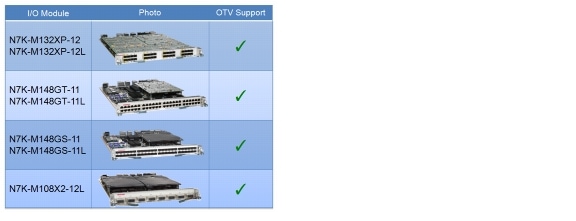- Cisco Community
- Technology and Support
- Data Center and Cloud
- Other Data Center Subjects
- I'm using NX-OS 6.1(1). The
- Subscribe to RSS Feed
- Mark Topic as New
- Mark Topic as Read
- Float this Topic for Current User
- Bookmark
- Subscribe
- Mute
- Printer Friendly Page
Using M1 and F1 ports in OTV set up
- Mark as New
- Bookmark
- Subscribe
- Mute
- Subscribe to RSS Feed
- Permalink
- Report Inappropriate Content
05-13-2014 11:12 PM - edited 03-01-2019 07:34 AM
I am building a typical OTV architecture (on a stick, not inline) on Nexus 7000s; the join and internal interfaces in my OTV VDC are using M1 card ports. Can the other end of those links -- i.e. the interfaces in my Agg VDC -- use ports on my F1 card? Or do both ends of the internal and join links (all 4 ports) need to be on my M1 card? Asking because my M1 card is full at present.
- Labels:
-
other data center topics
- Mark as New
- Bookmark
- Subscribe
- Mute
- Subscribe to RSS Feed
- Permalink
- Report Inappropriate Content
05-14-2014 12:40 AM
Hi,
What is your nexus version ?? , below version 6.0 don't support on F1 module . 6.2 version supports on F1 module .
Version 6.2
OTV
The following Overlay Transport Virtualization (OTV) features are available in Release 6.2(2):
- The VLAN translation feature allows you to connect applications that reside in separate Layer 2 domains between data centers.
- Selective unknown Unicast flooding is a per MAC address configuration that allows OTV to flood across the DCI for the specified MAC address. This feature is particularly helpful for applications that go silent and timeout from the ARP tables.
- Dedicated broadcast group allows you to configure a separate multicast address for broadcast traffic. This feature is useful for organizations that need separate QoS policies for broadcast traffic.
- OTV has built-in BFD support that does not require any additional configuration on the OTV side, which helps with any reconvergence that OTV might have to handle.
- The scale of OTV and how fast it converges are improved in this release.
- F1 Series and F2e Series modules can be used as internal interfaces with the OTV VDC.
Version 6.0
OTV Hardware Support and Licensing Information
The only Cisco platform supporting OTV functionality at this time is the Nexus 7000. Figure 1-37 shows all existing M1 linecards OTV fully supports.
Figure 1-37 M1 Linecards Supporting OTV

Full support essentially means that both Join and internal interfaces can be configured on one of the M1 modules mentioned. OTV on F1 modules is not supported on NX-OS releases shipping at the time of writing of this document (5.2 and 6.0 releases) and will be introduced in a future software release but restricted only to internal interfaces (an M1 linecard will always be required on the OTV edge device to source the OTV encapsulated traffic out of the Join interface).
HTH
Sandy.
- Mark as New
- Bookmark
- Subscribe
- Mute
- Subscribe to RSS Feed
- Permalink
- Report Inappropriate Content
05-14-2014 08:14 AM
I'm using NX-OS 6.1(1). The wording in these docs is ambiguous. The phrase for OS 6.2 stating "F1 Series and F2e Series modules can be used as internal interfaces with the OTV VDC" could be interpreted as referring only to the port used as the internal interface in the OTV VDC, whereas my question is about the port in the *other* VDC, the Agg VDC in my case. In that VDC there is no OTV configuration and the port linking over to the OTV VDC internal interface is configured the same as any other outbound trunk interface in the Agg VDC.... so does that port *also* need to be on the M1 card? That is what is not clear to me. And those documents do not clearly speak to this question that I can find.
thanks,
Jim
Discover and save your favorite ideas. Come back to expert answers, step-by-step guides, recent topics, and more.
New here? Get started with these tips. How to use Community New member guide


